STEAM activities engage skills from various educational disciplines (Science, Technology, Engineering, the Arts, and Math) to invite young kids to discover new knowledge through inquiry and solution-based learning. By combining playful investigations in Early Childhood with a STEAM Education approach to learning, young kids are challenged to use cross-disciplinary and critical thinking skills to explore how ALL learning is connected to their everyday world!
Come explore and PLAY this week as the Early Childhood Education Team offers FALL STEM activities! This post will add “the ARTS” to STEM for a STEAM approach to learning about tessellating shapes in Early Childhood!
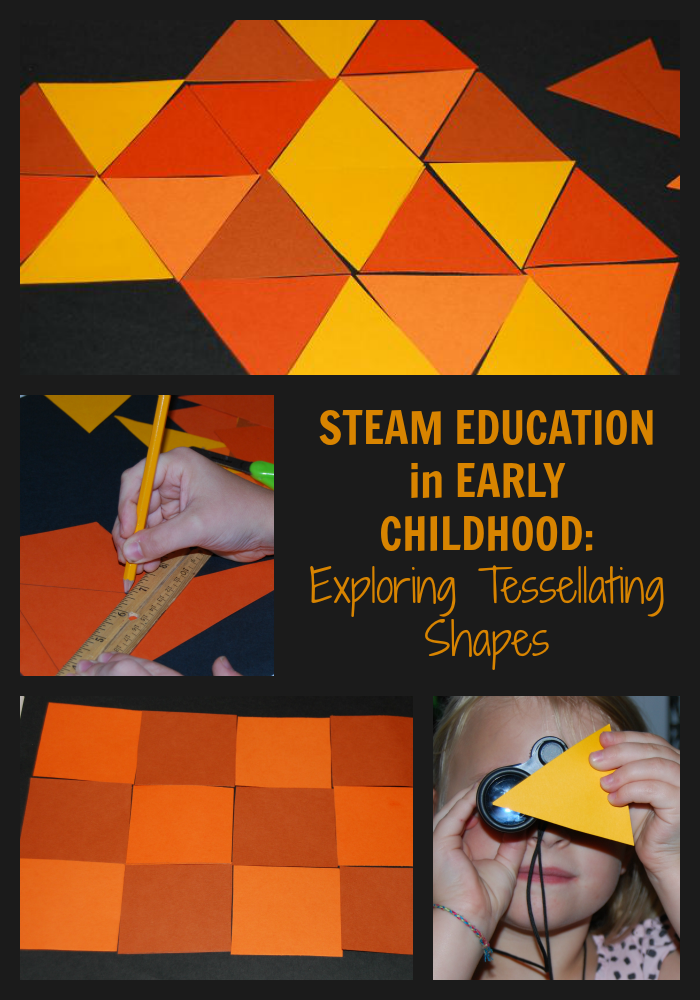 STEAM EXPLORATIONS IN EARLY CHILDHOOD: TESSELLATING SHAPES
STEAM EXPLORATIONS IN EARLY CHILDHOOD: TESSELLATING SHAPES
STEAM Skills Presented:
Science: Students will use skills within the scientific method: observing, communicating, comparing, organizing, and relating. Students will also investigate tessellating patterns found in their everyday world.
Technology: Students will use mobile technology to create tessellations and digital technology to document learning.
Engineering: Kids will engineer a tessellating pattern using geometric shapes.
Arts: Kids will construct a tessellating pattern that reflects the student artist’s creative choices.
Math: Kids will employ measurement skills and experiment with geometric shapes, lines, and patterning as they design their tessellations.
Background Information for Parents and Teachers: Tessellations are connected patterns made of repeating shapes that cover a plane (a 2-D flat surface that is infinite) completely without leaving any holes. A checkerboard is a basic tessellation composed of alternating colored squares – the alternating colored squares meet with no overlapping and can be extended on a surface forever. Tessellations have been used for thousands of years in architectural designs and structures (tiles and mosaics are examples). The artist M.C. Escher (Dutch artist – 1898-1972) is known as a master of tessellation artwork. M.C. Escher portrayed realistic objects (fish, birds, and others) in his drawings and tessellation prints.
Tessellations have 3 basic characteristics:
- Tessellations are repeating patterns.
- Tessellating patterns have no gaps or holes in the pattern and do not overlap.
- Tessellations can go on infinitely on a plane (flat surface).
Invite kids to look around the house or classroom to see if they can find tessellating (tiled) patterns. Many classrooms and homes have tiled walls, tiled flooring, and/or tiled ceilings. Those structures tessellate space because they fit the attributes above. Discuss the following questions:
- What shapes can the kids locate that tessellate space?
- What shapes or patterns would not work to create a tessellating pattern?
Discuss various shapes to see if the children can predict what shapes will tile a plane. There are 3 regular polygons that tile a plane:
- Squares
- Triangles
- Hexagons
Ask the kids if they think circles will tessellate space. Invite the kids to draw circles (close together, but without overlapping) and fill a sheet of paper – (for younger children make an example to display). Discuss whether or not the kids think that circles are a tessellating shape based on the 3 characteristics above.
Exploring Tessellating Shapes in Early Childhood!
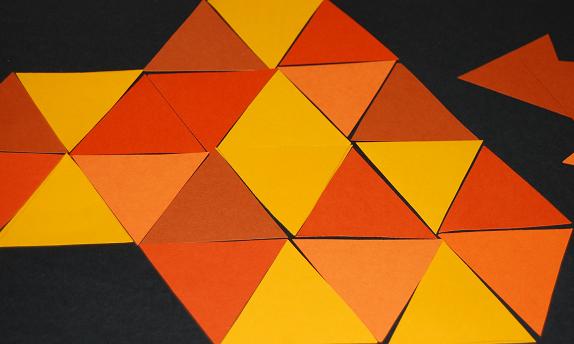 The tessellation activity below invites kids to use cross-disciplinary and critical thinking skills to explore shapes that tessellate space.
The tessellation activity below invites kids to use cross-disciplinary and critical thinking skills to explore shapes that tessellate space.
Materials needed:
- Heavy Paper (at least two different colors) – *Note – this activity can be “evergreen” for any season simply by using seasonal printed papers or seasonal colors.
- Scissors
- Ruler
- Glue Sticks
- Cardboard Templates for squares and triangles
- Mounting Paper
Set out all supplies on a large tray or table. Older kids can measure and cut their own templates for the various shapes. Younger kids may need a pre-cut template to trace or shapes that have been cut out prior to the activity.
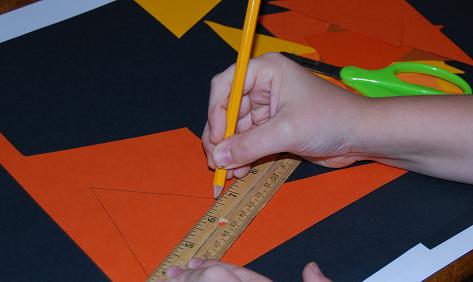 Invite the kids to cut or use the various shapes to create a tessellating pattern on the mounting paper. The kids will experiment with design and engineering as they work to create their tessellations in an open-ended construction experiment. It’s really amazing to stand back and observe the various design strategies as kids work to construct their tessellating patterns!
Invite the kids to cut or use the various shapes to create a tessellating pattern on the mounting paper. The kids will experiment with design and engineering as they work to create their tessellations in an open-ended construction experiment. It’s really amazing to stand back and observe the various design strategies as kids work to construct their tessellating patterns!
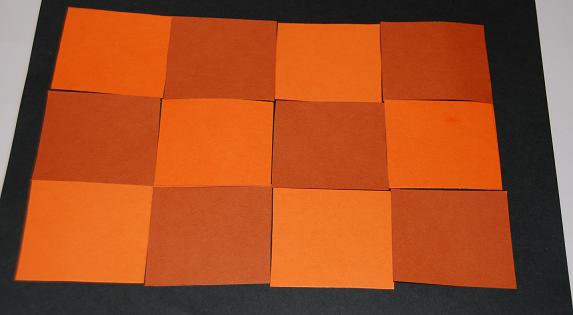 As the kids finish their tessellation designs, they can mount the final version to the paper with glue sticks. The tessellations make great displays at home or in the classroom!
As the kids finish their tessellation designs, they can mount the final version to the paper with glue sticks. The tessellations make great displays at home or in the classroom!
Documenting Learning: Have the kids use digital cameras to take photos of their finished tessellations. The kids can print the photos to create a tessellation class book or share the photos in an online slideshow for family and friends!
Tessellating Patterns Found in the EVERYDAY World!
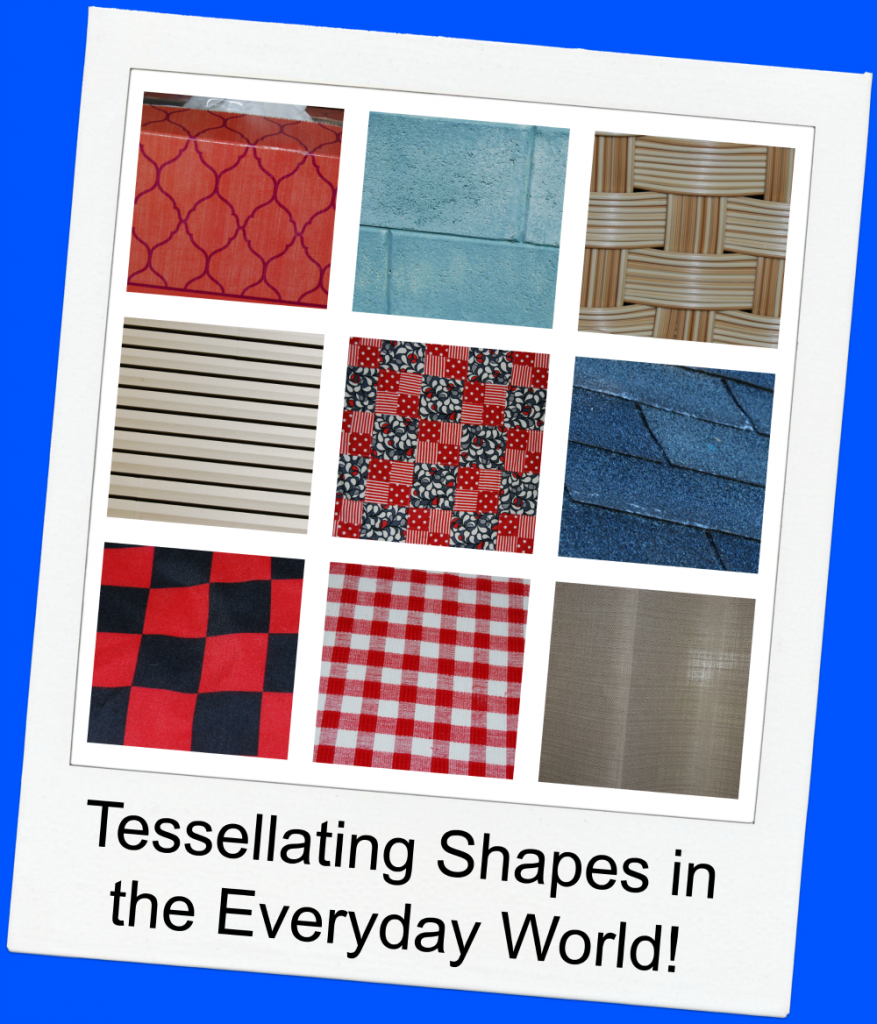 Tessellating patterns are found EVERYWHERE! To expand and help document learning, have kids search for additional tessellating patterns found in their everyday world. Invite kids to use digital cameras (or ask parents to assist in documentation from home) and take photos of tessellations they find in the classroom, in nature, at home, or in the community! Our kids found tessellating patterns in:
Tessellating patterns are found EVERYWHERE! To expand and help document learning, have kids search for additional tessellating patterns found in their everyday world. Invite kids to use digital cameras (or ask parents to assist in documentation from home) and take photos of tessellations they find in the classroom, in nature, at home, or in the community! Our kids found tessellating patterns in:
- Textiles (curtains and rugs)
- A wasp nest
- A soccer ball
- Tiled ceilings and flooring
- The brick foundation of a home
- A quilt
- A tissue box
- Siding on a home
- A checkerboard placemat
- A checkerboard blanket
Mobile Technology Extension Activity – Digital Tessellations
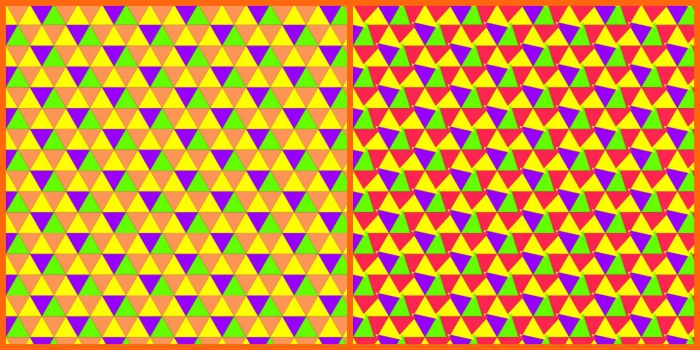
The Tesselations App by David Rasch is available for iPhone and iPad. If students have access to mobile technology, the app is a fun one to use for creation of basic digital tessellations. Students will choose a template from the drop-down menu, select the color(s), and then use touch-screen skills to move the basic square to create various tessellating patterns. The photos can then be saved within the app and printed for additional documentation of learning.
Exploring tessellations through a cross-disciplinary STEAM approach helps kids relate learning to the real world. When students are given the opportunity to recognize geometric shapes, mathematical relationships, and engineer the tessellating patterns, they can then begin to apply newly gained knowledge and critical thinking skills to problems they encounter in their own world!
For MORE ways to play and learn with FALL STEM, please visit the activity suggestions from the dedicated #TeachECE Educators below:
Witchs’ Brew: Fall STEM Sensory Play by Still Playing School
Fall Playdough Engineering Challenge by Capri + 3
Five Little Pumpkins STEM Activity by Munchkins and Moms
Playdough Parts of an Acorn by Learning to Walk
Fungus investigation with FREE Printable by Rainy Day Mum
The Itsy Bitsy Rhyming Spider by Growing Book by Book
How Long Am I? Measuring with Leaves by Tiny Tots Adventures
Pumpkin Math and Engineering Challenge by Fun-A-Day
FALL STEM Challenge for Kids: Leaf Sculptures by The Educators’ Spin On It
Learning Letter with a FALL STEM RAMP Activity by Mom Inspired Life